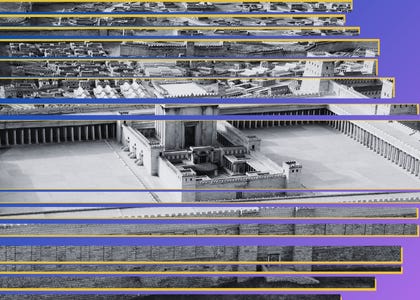Welcome to Highways to Zion. I’m glad you’re here.
Long ago, the sons of Korah the Rebel composed what Spurgeon called, “the Pearl of the Psalms.”1
“How blessed is the man whose strength is in You,
In whose heart are the highways to Zion!”
— Psalm 84:5
This beautiful Psalm is a song in which those who sing it are longing for the Temple; for God’s abode. For an ancient Israelite, this idea was huge. The Temple was everything. And often, it was referred to as “Mount Zion.” One scholar puts it this way:
“The Temple of Yahweh in Israel was naturally associated with a cosmic mountain dwelling like Sinai because it was situated in Jerusalem on Mount Zion, the new Sinai.”2
In their trek to Jerusalem, people would anticipate being able to come and worship Yahweh in His house, where He lived — and for them, this concept was no mere symbol. They were going to go and be with God.
And what did they take? A highway.
Now, whether you think these were pre-exilic pilgrim songs or Babylon-era refugee anthems3, it really doesn’t matter because the message is the same. Humanity needs Zion. All of the universe is on a trajectory sprinting towards that Mountain; towards God’s abode. We need God, whether or not we are convinced of it. He is the Source of all things and the Healer of our damaged souls.
Our hearts are often not the best compasses. As in the great hymn from long ago, “Prone to wander, Lord, I feel it” rings true of the human condition and our desperate necessity for divine direction. If you feel lost, sometimes you need to get back to the highway.
Here you’ll find ideas and methods for getting us back on track towards Zion — towards God’s abode. Whether it’s a song, or a devotional practice, or an analysis of current issues of leading in church ministry, or a Biblical challenge to your present paradigm, my goal is to encourage you to abandon everything in the pursuit of King Jesus and His glory. He wants to be known by you. He already knows you so well.
Spurgeon, C. (2004). The Treasury of David: Spurgeon’s Classic Work on the Psalms. Kregel Academic.
Heiser, M. S. (2015). The Unseen Realm: Recovering the Supernatural Worldview of the Bible, 226.
Wallace, R. E. (2011). The Narrative Effect of Psalms 84–89. The Journal of Hebrew Scriptures, 1-15. https://doi.org/10.5508/jhs.2011.v11.a10








Exactly. The temple and Mount Zion reflect the same cosmic structure, broad at the base/outer courts, slowly gathering into divine unity and purpose at the top/inner sanctum. They also represent the structure of our being, disparate members drawn into identity and purpose at our core where heaven and earth meet.